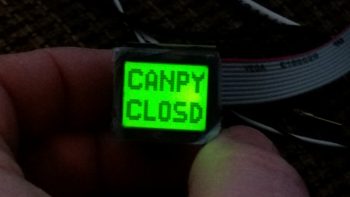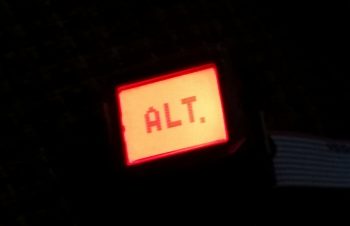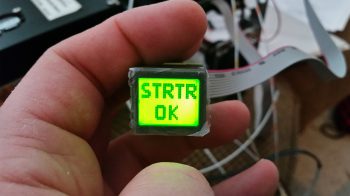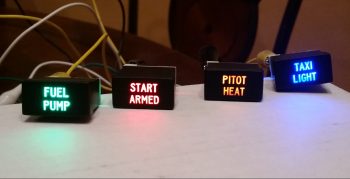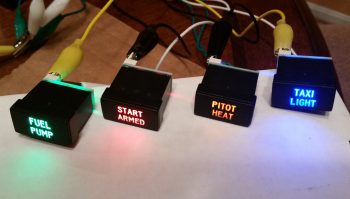As I mentioned before, sideline to getting back into the books and refreshing my tired mind on Instrument flying stuff, I’ve been cleaning up some electrical system stuff that is a natural result of integrating systems and devices together.
One such area of my electrical system is on the warning annunciators. I decided to crack the code on just how these AG6 annunciators (again, I have 2) are programmed. Well, the programming manual might as well have been written in Mandarin Chinese when I started, but after working through it bit by bit I finally got the swing of it. The weirdest thing about these annunciators is that you only have one interface to program them, the button –also the annunciator screen– which makes things interesting. There are only 2 inputs that the screen recognizes, akin to Morse code: a short press [<0.7 sec] and a long press [>0.7 sec]. It also recognizes the rate and combinations of these presses together (analogous to the ‘double-click’ on a computer). Again, once I worked at it a few times the input was really a non-issue. Add a little patience and it’s actually something new and fun.
One issue I had was that I failed to realize that there was an online spreadsheet that had the codes that I needed to program (or reprogram) these annunciators. My being remiss in having this critical document on hand was evident after a few telephone and email discussions that I had with Rich from aircraftextras.com.
With the spreadsheet in hand I was able to effectively program about 80-90% of the input screens that I wanted. To be clear, I had the installation manual that described the entire programming process, but what I didn’t have was the spreadsheet that had the required codes to tell me what screen ID numbers to input for the warning screens that I wanted annunciated… until after talking with Rich of course!
Since the AG6, as with what seems like the majority of experimental aircraft products these days, is traditionally geared towards the RV crowd, there are some unique warning annunciator screens I would like that are not on the list of hundreds of screens already preprogrammed on the AG6.
After finalizing all the programming I could do, I determined that I needed 2 completely new screens and slight modifications to 2 other screens to provide me what I’m looking for in my warning annunciation scheme. The 2 new screens are “IBBS Low V.” for my IBBS unit, and “RAM OPEN” / “RAM CLOSD” for my engine RAM air intake.
As for the pics above, I would like to point out that the top pic portrays the actual visual appearance the best of these 3 pics. A brilliant, bright red light is really hard to capture with any of my cameras, and comes out looking orange and pale, and is not representative of its actual appearance (the same thing holds true for the indicators below).
Finally, the top pic showing “CANPY CLOSD” is one that I want changed to “CANPY LOCKD” (there is a screen ID for the latter, but for some reason it too is showing as simply “CANPY CLOSD”). There will be no “ALT.” screen, but rather “Low Volts” for the main bus low volt state (via the B&C LRC-14 voltage regulator).
The last pic above is the annunciation that will show up for a few seconds immediately following engine start to show that the starter solenoid is not hung up (“hung start”). As a reminder, a hung starter state is dangerous since huge current flow is rushing through the system from battery to starter and back unabated, which will fry the battery… with even possibly more bad smoking, fiery stuff to follow (Dick Rutan addresses this in CP #99). To be clear, the more important screens are the red, flashing warning annunciations that will come and stay on until recognized with a screen press, or the warning state ceases on its own. Thus, the entire time the starter is powered there will be a flashing red light depicting “STRTR ON” until it’s disengaged, at which point the green annunciator screen shown above will flash on.
Moving on…
As I mentioned the other day, in my quest to finalize both my warning annunciation scheme and my device ON/OFF indicators (below) I ran across a discussion from Paul Dye (Editor in Chief of KITPLANES mag) arguing that a simple, separate, non-EFIS or engine management system linked low oil pressure light should be incorporated into one’s lineup as a primary tell-all of engine health if your spiffy, modern glass cockpit goes Red-X on you.
I thought that for 2.3 oz it sounded like some good informational “need-to-know” insurance, so I bought this oil pressure switch from B&C to incorporate its alarm out state as an input into the AG6. When the oil pressure is low (as in pre-engine start) a red, flashing “LOW OIL P.” annunciation will alarm (this is an adjunct warning light, not a replacement, of the EFIS-depicted engine instrumentation).
This oil pressure switch actually has 3 electrical connections to allow for a Hobbs meter to be wired up as well, if so inclined. Here’s the back of the oil pressure switch, showing the N.O., N.C. and COM electrical connection posts.
Lastly — something I’m extremely pleased with is these babies below that were delivered today! Again, as I mentioned before, after I assessed my warning light system I decided that I would revise my original decision to run all but one pair of LED panel indicators through the AG6 annunciators, in order to make the AG6s strictly inflight/actual warning annunciators. Thus, those devices that I simply wanted to know were in an ON or OFF state would get downgraded to just LED lights again.
Now, I did order a myriad of LEDs in one my of Mouser orders, but my spidey sense told me there had to be something better out there. After messing about online a bit here & there over the past few weeks, I found these. They’re simple LED indicators for airline cockpit simulators that I found on Ebay (these are 737 panel indicators). I wasn’t sure if they would work, but at less than $4 a piece, I figured I would pull the trigger and test them out. I’m very glad I took a chance!
Again, the red and green indicators don’t photograph well, although the blue and amber lights are fairly good depictions of how they look. These 4 items are the ones which I wanted their ON/OFF states communicated since –other than the fuel pump under my thigh support– I would have no real way of knowing if they are actually in an on or off state (yes, I could tell if the taxi light is on at night, but how about during the day?).
Best of all, these are low current and very lightweight indicators, with all 4 weighing in at less than 0.05 lbs. I will run them through a dimmer so that their brightness can be dimmed at night, and turned up to their brightest during daylight flying. One point of note is that I reserved the brightest LEDs (red & blue) for the ground op devices: START ARMED to indicate when the engine starting system is ready, and the TAXI LIGHT on indicator. This leaves the FUEL PUMP and PITOT HEAT as the less bright, but still clearly visible, indicator lights for flight ops. In addition, I reserved the only red light, denoting an actual real hazard, for the START ARMED indicator… since a swinging prop typically ensues immediately after it lights up. So, although definitely listed in the “great-to-know” category, the other indicator lights (and their associated colors) do not denote hazardous states.
Ok folks. Transmission ended, and back to studying for me!

